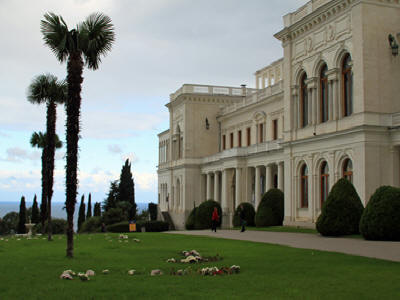|

Yalta and Odessa, Ukraine
We travelled into the Black Sea to
the Crimean peninsula of Ukraine. Our first port of call was
Yalta, and our second, Odessa. Both are attractive cities of
historical importance still recovering from the Communist
influences of the Soviet Union, and now, regrettably, no longer
open to tourists due to Russian incursions.
|
|

The port city of Yalta has
a modern seafront promenade featuring designer shops and
American fast food.
|

Livadia Palace was the
last Tsar's vacation residence. It was host to Stalin, Churchill
and Roosevelt for the Yalta Conference in 1945, in which they
planned the division of Europe at the end of World War II.
|
|

Vorontsovsky Palace
in Alupka was home to Prince Mikhail Semyonovich Vorontsov,
Russian Field Marshal known for his exploits during the
Napoleonic Wars.
|

The Palace is a mixture of
Middle-Age and Moorish design and is surrounded by unique
botanical gardens.
|
|

Since the 19th century,
when VIPs came to cure their illnesses, and later communist-era
citizens who got the privilege to go there, the Crimean area has
been a Riviera-like vacation resort.
|

We travelled by funicular
up Ai-Petri, a spectacular limestone peak from where we had a
panoramic view of the Black Sea and the Crimean coastline.
|
|

At the summit plateau,
there's a tiny Tatar hamlet, where the people make a living
selling food and drink and offering guided pony or camel rides.
|

Handicrafts include
sheepskin clothing, curly-toed shoes and embroidered bags.
|

Ekaterininskaya square signifies
the founding of Odessa in 1794 by Catherine the Great
when the Russian Queen decided her empire could use a
port on the Black Sea. |
![[ru]Одесса, Спасо-Преображенский собор[en]Odessa, Spaso-Preobrazhenskiy Cathedral](Ukraine_Odessa_021.jpg)
Spasso-Preobrazhenskiy cathedral, constructed in 1795, was one
of the biggest in Russia. It was ordered dynamited by Stalin in
1932. It has been gradually rebuilt since 1999.
|

The Potemkin Stairs are
a formal entrance into the city from the direction of the sea.
The 192 stairs leading from Prymorsky Boulevard down to the sea
were constructed from 1837 through 1841.
|

Deribasovskaya Street is a
pedestrian walkway in the heart of Odessa. Next to the
street is Odessa's first park, which was built shortly after the
foundation of the city in 1803. This park has a fountain,
bandstand, and several monuments.
|
|

Odessa Opera and Ballet
Theater (1809) once echoed with concerts conducted by Peter
Tchaikovsky and ballets featuring Anna Pavlova.
|

Ivan Martos's statue of
the Duke of Richelieu stands in front of one of the many
neoclassical style buildings. |
|

The "Golden Child"
statue by Ernst Neizvestny stands at the Port entrance.
|

Craftspeople continue the
tradition of carving and painting Easter eggs and nesting dolls.
|